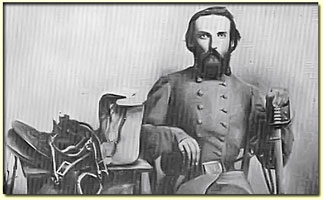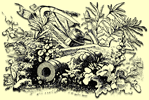Account
of the Lost Cannon on Cotton Hill
 A CIVIL
WAR NARRATIVE
A CIVIL
WAR NARRATIVE
As
told by Captain J. H. Abbott.

Captain Abbott,
CO. H 8th Virginia Cavalry,
Salem, Virginia 1864
From
memory, I will try and give you a statement of what occurred in Fayette
county during the Civil war, commencing with the battle of Cross Lanes,
Nicholas county, which was fought September 11, 1861.
I
was then second sergeant of Company K, 22nd Regiment, Fayetteville
Rifles. I volunteered to carry a dispatch to General Chapman,
commanding the militia of Monroe, Raleigh and Fayette counties, at
Fayetteville, and was detailed to help organize and drill his troops
which were stationed at Fayetteville and Cotton Hill.
About
ten days after my arrival at General Chapman's headquarters, we received
information that General Cox was marching up the valley and that his
advance guard had reached Kanawha Falls. Captain Herndon's company
of the 8th Virginia cavalry, acting as our scouts, was ordered over
Cotton Hill. Nine of his men were killed from ambush on Falls
Branch and were hauled over Cotton Hill on sleds drawn by oxen and
buried on a knoll at the foot of Cotton Hill on the farm of T. S. Robson.
Two
days later three companies of the militia were ordered on a scouting
trip over the mountain to Kanawha Falls. I commanded one company,
Lieutenant Loughborough, adjutant for General Beckley's brigade, commanded
the second, and Captain Richards had charge of the third. We
met the advance guard of the Federal troops on Falls Branch, near where
Captain Herndon's men were killed. Captain Hunt, who was in charge
of the Federals, surrendered to Lieutenant Loughborough when ordered
to do so; but he picked his chance, drew a revolver, fired and killed
our officer and then made his escape with his men. We brought
the Lieutenant over the mountain and buried him with the others. The
Cox army crossed Cotton Hill and a fight ensued. We retreated
to Fayetteville. There being no field officer for the Fayette
regiment, I was appointed lieutenant colonel and was in command until
we disbanded at Beckley.
The
first Union officer that came into Fayetteville rode to the court house
square and down to the old well in the corner, where he was shot and
killed by one of our own men.
Late
in the fall the militia was disbanded at Raleigh court house. I
then reported to General Heath, who made me a member of his staff with
the rank of captain. We wintered in the narrows of New river. At
the re-organization of the army in April 1862, I was elected second
lieutenant of Company H, 8th Regiment, Virginia Cavalry, known as the
Tazewell Troopers, but remained with General Heath until after the
battle of Lewisburg, May 23, 1862.
General
Loring, about September 9th, moved down on General Cox's army then
located at Fayetteville, where he built fortifications. I was
ordered to pilot a detachment of cavalry through the woods to Cotton
Hill, cut the wires, and hold the road until forced away. We
got axes from David Harshbarger and cut the poles and wires to the
top of Cotton Hill, then went up the road to the red bank on George
Tyree's place where we could see the road leading down to Miller's
ferry. All day they went down the Hawks Nest road, crossed the
river at Miller's Ferry, and went down the other side of the river
to Gauley Bridge. Cox's men made no effort to dislodge us. And
all day the battle at Fayetteville raged.
Late
in the evening of September 10th, a regiment of Federal infantry crossed
Cotton Hill and came up on our rear, cutting off our escape up Laurel
creek. We had but one way to retreat, and that through the woods
back to our army, which we did with great difficulty. The fighting
was still going on and continued till long after dark when all became
quiet. Some of the men laid upon their arms and slept.
The
next morning, September 11th, General Cox's army was gone, and our
army followed as quickly as possible. At the top of Cotton Hill,
General Loring ordered a brass cannon to be taken down a long ridge
to the top of the cliffs overlooking Gauley Bridge. We planted
the gun and knocked down the temporary bridge across Gauley and blew
up the magazine in the mouth of Zoll's Hollow, and then trying to get
the gun back and finding it a difficult job, we hid it in a deep ravine,
and it is there yet. General Loring continued his pursuit of
General Cox and fought the battle of Charleston, September 13th. The
army retreated back through Fayetteville about November 15th, in a
continual fall of rain, and many of the soldiers died from exposure. Several
died of pneumonia and measles.
During
the summer of 1863, General J. B. McCausland made a raid on Fayetteville
with three regiments of infantry, the 22nd, 36th, and 45th, and three
companies of Cavalry. We advanced into Fayette county without
any trouble until we were about two miles below Mount Hope, where we
dismounted and sent our horses to the rear. We formed behind
a rail fence running up the ridge by a large chestnut tree standing
on a knoll above the Warner log house. We did not have long
to wait. They came up, jumped their horses over the fence, and
wound their way up the hill. When they got within close range,
we fired, and seven or eight of them fell from their horses and rolled
down the hill. These men were buried under or near the large
chestnut tree.
That
evening Captain Phil Thurmond dropped into our camp and said that his
men were on Arbuckle creek and that he would throw the plank off the
bridge above Rook Huddleston's mill, if we would run the cavalry into
it. The next morning we came on the pickets at the Hickman place,
and one man was killed. We next met them in force on top of the
hill above Oak Hill and charged them into the bridge. The first
horses went in on the sills and stuck fast. Some ran over the
cliffs below the mill and were killed. We rescued sixteen live
horses wedged in the bridge, and about fifty revolvers and as many
carbines were captured. About twenty-five men men were killed
on both sides. We arrived near the town that evening and went
into camp. I was ordered to take a few good men to Cotton Hill
and cut the wires, which we accomplished. We captured three fine
teams and returned safe. The firing continued on the fortifications
until late in the evening, when our retreat commenced.
About
the first of November our cavalry was left in Raleigh to guard the
road and to use some forage on the Ferguson and other neighboring farms. Captain
Irvin Lewis with part of his three companies made a raid down lower
Loop creek to its mouth, surprised and captured sixty-five men and
seventy-five horses and equipment. We retreat out up Armstrong
creek, crossed over Payne's mountain, where we rested and ate up everything
we had. We went down a ridge to Paint creek and the to Raleigh
court house. The prisoners were sent to Dublin depot.
In
1864, I was stationed at Princeton, and on July 4th, I raided Fayetteville
and captured four sutler wagons and a large quantity of all kinds of
goods, and carried the goods out on our horses. These wagons
were placed outside of the lines for the purpose of trading with the
people on that day.
I
wish to add that I became captain of my company by the promotion of
Captain Henry Brown to the rank of major.

CIVIL WAR ~ PRINTS & GRAPHICS ~ BOOK
PUBLISHING ~ STORE

![]()